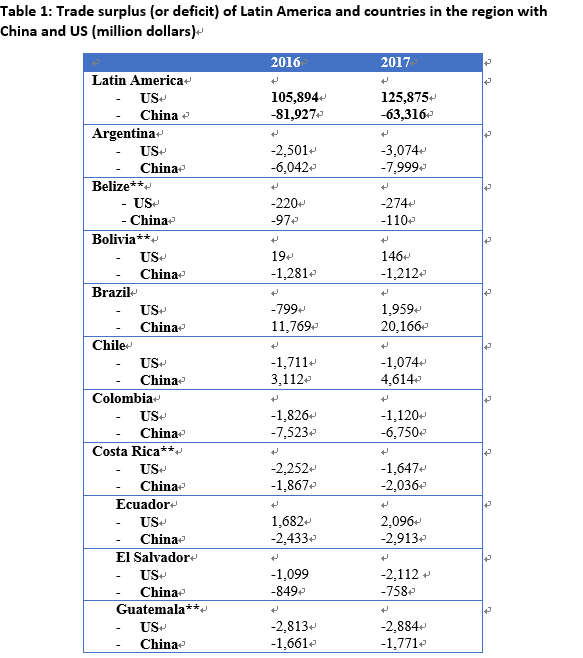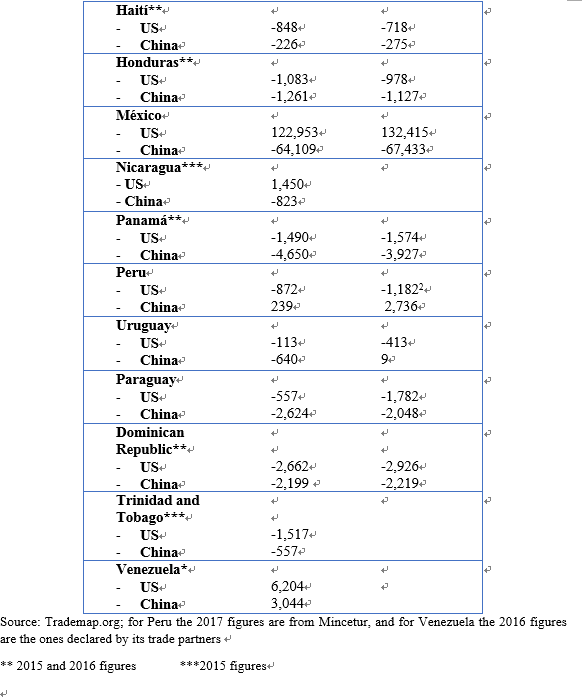


The US Secretary of Commerce Wilbur Ross during his participation in the VIII Summit of the Americas in Lima said that Latin America should look to the US and not to China because it is better for them. To support his claim he said that Latin America has a trade surplus with the US while it has a trade deficit with China. He also said that Latin America exports manufactures to the US but only raw materials to China . What he said is not true, it is a half-truth or even a lie.
Although Latin America as a region had a trade surplus with the US of 125.8 billion dollars in 2017 and had a trade deficit with China of 63.3 billion dollars that same year (see Table attached), the figures are distorted by the large trade surplus that Mexico has with the US and the large trade deficit that Mexico has with China.
As seen in that table, which also shows the trade balance of China and the US with most of the countries in the region, Mexico had a trade surplus with the US of 132.4 billion dollars in 2017, and with China had a trade deficit of 67.4 billion dollars. But many Latin American countries had a trade deficit with the US. For example Argentina, Chile, Colombia, Guatemala, Honduras, Panama, Peru, Uruguay, Paraguay, among others. And several countries had trade surplus with China, such as Brazil (20.166 billion dollars), Chile, Peru, Venezuela. Then Mexico distorts the figures, and if this country is excluded from the figures of the region, then the trade balance of China and the US with the region is quite different, where the region had a large trade deficit with the US and a small one with China. The trade deficit of 22 Latin American countries (excluding Mexico but also others small countries, and Cuba which does not trade with the US) was of 12.9 billion dollars, while with China was of only 4.2 billion dollars (figures for 2017 or the last available year, see Table below). So the trade deficit of the region (excluding Mexico) with US was three times larger than with China.
As for the assertion that Latin America sells mostly manufactured goods to the US and raw materials to China, this is also half true or not true. Once again, if Mexico is excluded (this country mostly sells manufactured goods to the US) it will be found that the region sells to China and the United States mainly raw materials and import of them manufactures. Neither China nor the US are to be blame for the fact that Latin America sell to them mostly raw materials, because the region unfortunately has not developed a competitive industry. If you still want to find a culprit, this would be the US and not China, because the region has only recently increased its trade with China, from the last decade, while with the US it has been trading for a long time.
Instead, the region has benefited from trade with China because this country buys more and more products from the region. Thanks to China demand, the prices of raw materials have risen and this has undoubtedly benefited the region. In addition, China is investing a lot of money in the region, mostly in the extraction of natural resources but lately also invests in infrastructure, agriculture, finance and other sectors.
Nobody can tell the region to trade with one country and not with another. Latin America should trade with all countries, especially more with countries that grow the fastest, as is the case of China. Rather, the US has lately become protectionist, having withdrawn from the TPP agreement where it was together with Chile, Mexico and Peru, and is renegotiating the NAFTA agreement where it is with Canada and Mexico. In contrast, China has stated that it is in favor of an environment where free trade and investment are the norm and has expressed its willingness to continue opening its country to the world.


Carlos Aquino is Professor of Economics at San Marcos National University (UNMSM) and a specialist in Asian Economics. María Osterloh holds an MBA from the Normal University of Beijing and is a researcher in IEPA.

 Award-winning photos show poverty reduction achievements in NE China's Jilin province
Award-winning photos show poverty reduction achievements in NE China's Jilin province People dance to greet advent of New Year in Ameiqituo Town, Guizhou
People dance to greet advent of New Year in Ameiqituo Town, Guizhou Fire brigade in Shanghai holds group wedding
Fire brigade in Shanghai holds group wedding Tourists enjoy ice sculptures in Datan Town, north China
Tourists enjoy ice sculptures in Datan Town, north China Sunset scenery of Dayan Pagoda in Xi'an
Sunset scenery of Dayan Pagoda in Xi'an Tourists have fun at scenic spot in Nanlong Town, NW China
Tourists have fun at scenic spot in Nanlong Town, NW China Harbin attracts tourists by making best use of ice in winter
Harbin attracts tourists by making best use of ice in winter In pics: FIS Alpine Ski Women's World Cup Slalom
In pics: FIS Alpine Ski Women's World Cup Slalom Black-necked cranes rest at reservoir in Lhunzhub County, Lhasa
Black-necked cranes rest at reservoir in Lhunzhub County, Lhasa China's FAST telescope will be available to foreign scientists in April
China's FAST telescope will be available to foreign scientists in April